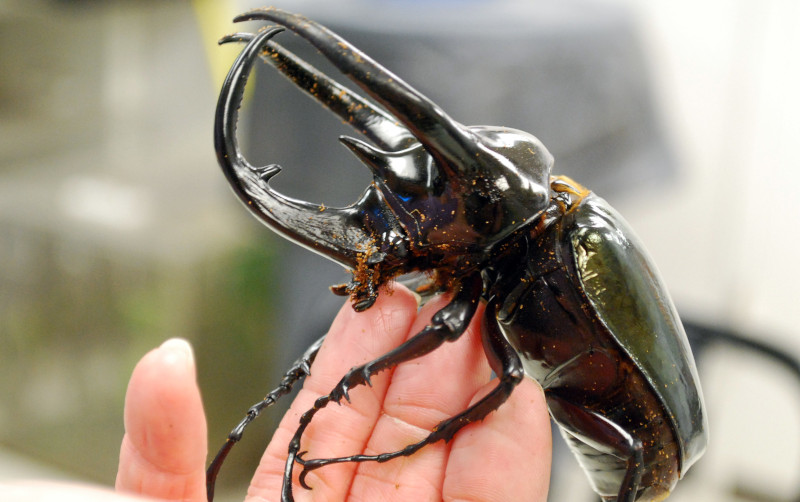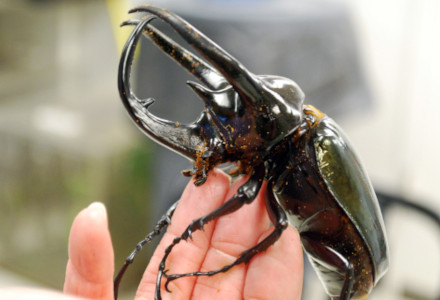
Atlas Beetle Facts
- This imposing creation of Nature most frequently goes by attention-grabbing, but deserved, common name of the Atlas Beetle. It does have at least one other, less often employed name, though. That’s the equally understandable term of Rhino Beetle.
- Among professionals, however, such as researchers, it’s better known by its official name. That’s actually reasonably easy to pronounce, at least as such things go. That’s because the remarkable insect bears the technical moniker of the Chalcosoma atlas.
- It further received that name due to the efforts of the highly respected Swedish researcher, Carl Linnaeus. He made the first recorded acknowledgement of it as a separate and distinct species. This scientifically noteworthy event took place in 1758.
- Currently, the Atlas Beetle seems to be maintaining a population base that’s both stable and sufficient. This fortunate fact further appears to hold true throughout the entirety of its range. The IUCN, therefore, presently has no listing for it on its Red List.
- The Arthropod nevertheless must be considered as facing at least some threats to its continued existence. Possible habitat loss naturally ranks high among these, due to human expansion. Its greatest threat, though, likely consists of climate change.
Related Articles
Atlas Beetle Physical Description
The mighty Atlas Beetle fully earns the impressive epithet. It does so, however, due to a combination of factors. Its striking appearance obviously qualifies as one of those. The first thing most observors note about this marvel, though, remains its sheer physical size.
True to the reputation of its namesake, this particular beetle ranks as one of largest of all known members of its Order. Also like most of those relatives, it displays a marked degree of the physiological characteristic of sexual dimorphism. In its case, this manifests in pure size.
More precisely, the males of the species attain a much greater length and mass than the smaller females. The impressive males reach a length that averages approximately 2.4 – 4.7 in (6 – 12 cm). Females, though, only average 0.98 – 3.6 in (2.5 – 6 cm) in total length.
In terms of overall appearance, however, both genders present the same pattern of coloring. That, though, varies significantly between individuals, regardless of sex. This typically fluctuates between a dark brown to a brilliant, almost iridescent metallic green shade.
The genders further differ slightly in the design of their legs. Among the males, these appendages generally develops as longer and thinner than those of the females. These features additionally most often possess a covering of thorny-looking protuberances.
The greatest gender-based difference manifested by the Atlas Beetle, however, appears on the head of the creature. That’s due to the fact that males alone develop three relatively large horns on their head and thorax. These average nearly as long as the body itself!
- Kingdom: Animalia
- Phylum: Arthropoda
- Class: Insecta
- Order: Coleoptera
- Family: Scarabaeidae
- Genus: Chalcosoma
- Species: C. atlas
Atlas Beetle Distribution, Habitat, and Ecology
The mesmerizing Atlas Beetle evolved as native to a moderately large section of the globe. That native range range also hosts an astounding array of other forms of live, both fauna and flora. Evidence further indicates, however, that it never naturally spread beyond that area.
More precisely, though, the insect developed natively to what’s now the southern and southeastern portions of Asia. But, within that broader range, the majority of its population resides within the borders of the country of Malaysia. The exact reason is unknown.
Given its geographical distribution, its preferred habitat type comes as no surprise. That’s due to the fact that most specimens observed resided in regions of tropical rainforests. Yet some individuals displayed an adaptability to other regions, as well as varying altitudes.
The preference for more tropical environments reflects many aspects of its lifecycle. Such regions provide it with adequate sources of both nourishment and camouflage. Some aspects of that lifecycle, however, continue to remain a mystery to researchers.
Among the mysteries surrounding the Atlas Beetle is the dietary practices of adults. It’s known, though, that the larvae typically feed on decayed wood. Those same larvae also hold a strong reputation for their fierceness. If food’s short, they often prey on each other!
No list of its own predators exists for the moment. Scientist do know that some varieties of bats and birds prey on them. Its larval stage typically last 5 – 7 months. Adults, however, generally live 8 – 10 months. Females lay eggs among the dense foliage of their region.
Species Sharing Its Range
Check out our other articles on 3 Rather Remarkable Rodents, Caspian Seal, McMurdo Dry Valleys, Moon Orchid, Black Mamba, European Eel, Wilson’s bird-of-paradise

